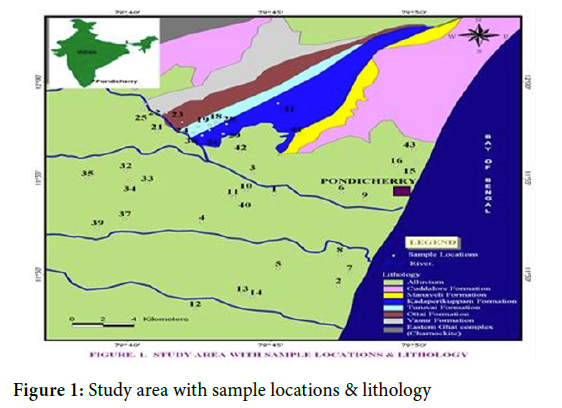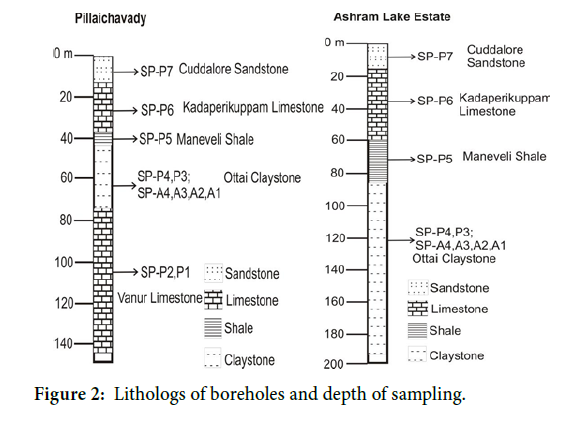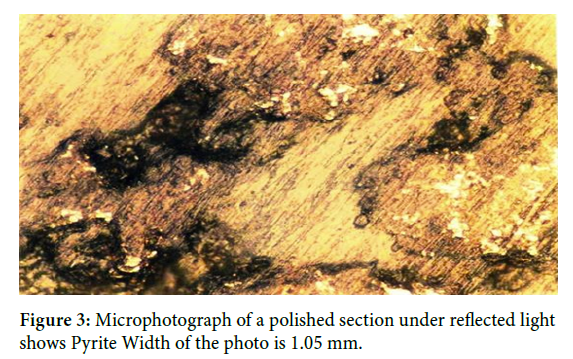Arsenic Contamination of Tertiary and Cretaceous aquifers in and around Pondicherry Region, India
Received: 01-Aug-2022 / Manuscript No. EPCC-22-001 / Editor assigned: 03-Aug-2022 / PreQC No. EPCC-22-001 / Reviewed: 17-Aug-2022 / QC No. EPCC-22-001 / Revised: 22-Aug-2022 / Manuscript No. EPCC-22-001 / Accepted Date: 22-Aug-2022 / Published Date: 29-Aug-2022 DOI: 10.4172/2573-458X.1000301
Abstract
The concentration of Arsenic was measured in 54 typical Groundwater samples were taken from a variety of aquifers throughout the Pondicherry region. including urban, rural, and industrial zones. Eleven sediment samples were also collected from two boreholes at various depths, representing various aquifer systems, and tested for various arsenic levels. Mineral-bearing minerals were studied using XRD and petrographic methods. The average quantity of Arsenic in groundwater was determined to be 25.02 μg/l, with a range of zero to102 μg/l. Around 54% of the samples contain more Arsenic than the World Health Organization's preliminary recommended level of 10 μg/l. XRD study of sediment samples revealed the presence of arsenic-bearing minerals in the aquifer systems, including Pyrite, Realgar, Arsenolite, Claudetite, Scorodite, Covellite, Enargite, and prosstite.Because of the interaction between arsenic-bearing minerals and pore water, the greater In the examined location, the concentration of arsenic in groundwater is primarily geogenic..
Keywords
Arsenic, Pollution, Groundwater, Sediments, Pondicherry, India
Introduction
Because of its extreme toxicity, Arsenic is one of the most harmful inorganic pollutants for the environment and humans .It's also one of the natural components of the earth's crust, with an average content of 2 to 3 μg/kg. Natural processes like as weathering of rocks and sediments, hydrothermal ore deposits, volcanic eruptions, and geothermal activity, among others, are responsible for the widespread high concentrations. Anthropogenic sources of Arsenic include mining, ore processing, thermal power plants utilizing coal or peat, chemical industries, and the indiscriminate use of pesticides and fertilizers in agriculture. (Figure 1) The World Health Organization reduced the maximum permissible concentration of Arsenic in drinking water to 10 μg/l in response to growing concern about this toxic carcinogen due to increased awareness of the dangers of Arsenic. If groundwater is to continue to be the world's primary source of public water, more excellent knowledge of the mechanism of natural Arsenic enrichment in groundwater is critical [1,2,3].
Several academics have attempted to determine the source, release mechanism, mobility, bioaccumulation, and health hazards connected with Arsenic in the recent past. Several researchers have tried to identify the source, release mechanism, mobility, bioaccumulation of Arsenic, and associated health risks during recent history.Pondicherry is one of the Indian regions that relies entirely on groundwater for drinking, irrigation, and industry. The r esearch o f Arsenic i n g roundwater was s purred b y excessive groundwater mining, intensive agricultural practices, and the geological environment.Study AreaThe Pondicherry area is the largest of the four isolated domains of the union territory of Pondicherry, which are located on India's east coast and comprise enclaves within Tamil Nadu's Cuddalore district. According to the 2001 census, the region occupies 293 square kilometres and is home to 179 localities with a total population of 0.6 million people.The research region i s primarily a flat pl ain with an average elevation of around 15 metres above mean sea level.
The climate in the Pondicherry region is tropical and humid. Temperatures fluctuate between 22 to 33 degrees Celsius every month. It receives 1281 mm of rain every year. The depth of the groundwater table ranges between 1.5 and 27 meters. Pondicherry is predominantly an agricultural region, with roughly 56 percent of the land devoted to crop production. Quaternary, Tertiary, and Mesozoic sediments occupy the area, with Archaean rocks serving as the basement rocks .The stratigraphic succession of the study area
Methodology
Fifty-four r epresentative g roundwater s amples w ere o btained f rom Pondicherry's aquifers, including urban, rural, and industrial locations. (Figure 2) depicts the locations of groundwater samples. The technique for collecting, preserving, and analyzing water samples was followed as instructed by APHA.The quantity of Arsenic in groundwater samples was determined using an Atomic Absorption Spectrophotometer. At two boreholes, one in Pillaichavady and the other in Lake Estate, eleven representative sediment samples were taken at various depths, representing all aquifer systems, including the Cuddalore, Kadaperikuppam, Manaveli, Ottai clay, and Vanur sandstone formations. The lithology and depth at which sediment samples were taken are depicted in the diagram. 2. Arsenic- bearing minerals were identified using a Petrological microscope to examine polished sections of sediment samples under reflected light. XRD technologyPANalytical XPert Pro X-ray powder diffractometer" in the two range of 15-750 utilizing CuK radiation via powder diffraction method was also used to identify the Arsenic containing minerals present the sediment samples. ata were used. An alfa level of 0.05 was regarded as statistically significant [4,5,6,7].
Results and Discussions
Arsenic contents in groundwater samples taken from 54 locations. The concentration of total dissolved Arsenic ranges from zero to 99 μg/l, with a mean value of 25.02 μg/l. (Figure 3) depicts the regional fluctuations of Arsenic in the groundwater of the study area. Arsenic in groundwater is obvious, and it is substantially higher in the Cretaceous aquifer system than in the Tertiary. The dissolved arsenic level is higher than the W.H.O. interim guideline limit of 10 mg/l established in 1993. In fifty-four samples, arsenic contents were less than ten μg/l in 46 percent. Around 28% of models have a concentration of 11 to 50 μg/l, and 26% have more than 50μ g/l. The concentration of Arsenic in groundwater samples [8,9,10,11].
The research region comprises sedimentary rocks such as sandstone, limestone, shale, peat, and unconsolidated marine deposits. In addition, iron sulfides such as pyrite and marcasite have been found in aquifer minerals. In addition, lignite seams can be found in the Cuddalore sandstone formation. Arsenic in natural water is typically linked to marine sedimentary rocks, volcanic rock weathering, fossil fuels, mineral deposits, mining wastes, agricultural wastes, and irrigational activities.The lithology of parent rocks influences the arsenic background content.Arsenic is found in sedimentary environments as a sorbed oxy-anion under oxidized circumstances. Arsenic is also absorbed into pyrite in reducing organic matter-rich strata, such as black shale, coal, peat, and phosphorite deposits. Arsenic concentrations in sedimentary formations range from 0.3 to 490 μg/kg in shale/clay, 0.4 to 188 μg/kg in phosphorite, 0.6 to 120 μg/kg in sandstones, and 0.1 to 20 μg/kg in limestones. Arsenic is estimated to be found in the lignite at a concentration of 7.41.4 μg/kg. In the Bengal delta plains, a significant amount of Arsenic has been found in combination with primary sulfide minerals, which are often associated with iron, aluminum, and manganese hydroxides, clay, sulfates, and carbonates is given in (Table 1)
| Era | Period | Formations | Lithology |
|---|---|---|---|
| Quaternary | Recent | Alluvium, laterite | Sands, clays, silts, kankar and gravels, laterite |
| Mio-Pliocene | Cuddalore Formation | Pebbly & gravely & coarse- grained sandstones with minor clays & siltstones with thin seams of lignite | |
| Unconformity | |||
| Tertiary | Palaeocene | Manaveli Formation | Yellow & yellowish-brown, grey calcareous siltstones and claystone & shale with thin bands of lime- stone |
| Kadaperikuppam Formation | Yellowish white to the dirty white sand. Hard fossiliferous limestone, calcareous sandstone, and clays | ||
| Unconformity | |||
| Mesozoic | Upper Cretaceous | Thursday Formation | Highly fossiliferous limestone, conglomerate at places, calcareous sandstone, and clays |
| Ottai Claystone | Grey to grayish-green claystone, silts with thin bands of sandy limestone, and fine-grained calcar- eous sandstone | ||
| Lower | Vanur Sandstone | Quartzitic sandstone, hard coarse- grained, occasionally feldspathic or calcareous with minor clays | |
| Ramanathapuram Formation | Black carbonaceous silty clays and fine to medium-grained sands with bands of lignite and medium to coarse-grained sandstone | ||
| Unconformity | |||
| Archaean | Eastern Ghat complex | Charnockite and biotite horn- blende gneisses | |
Table 1:Stratigraphic succession of Pondicherry area.
Agriculture / industrial pollution is fully ruled out as a source of Arsenic because industries do not employ arsenic-bearing raw materials in their manufacturing processes. The amount of fertilizers and pesticides used in agriculture is significantly less than the global average.Furthermore, Arsenic in arsenical pesticide-contaminated soil is likely to be essentially immobile in topsoils, while Arsenic in arsenical pesticide-contaminated soil leaches overdecades or longer time scales.Furthermore, it has been noted that Arsenic rarely migrates to depth, and Even in places where arsenical pesticides have been used, there is no evidence of arsenic poisoning of groundwater.As a result, the Arsenic in the research area's aquifers is geogenic in origin.
The mechanism controlling mobility and retention in solution has been studied extensively. Initially, it was considered that Arsenic was mobilized by oxidation of iron-rich pyrite due to over-mining groundwater, which resulted in higher oxidizing circumstances. The reductive dissolution of metal oxides and hydroxides of iron and manganese was later stated. Although the vital mobilization process is a reduction and Mukherjee elaborated on this revision of the initial reductive dissolution concept. Due to intricate Fe–As–S biogeochemical cycles, there may be some local re-oxidation and remobilization of sequestered from adsorbed phases. The existence of reducing conditions in the research area is indicated by the greater concentrations of HCO3 and iron in the groundwater. Furthermore, excessive groundwater mining has resulted in extreme drawdown, resulting in oxidizing circumstances. As a result, the overlapping decreased events may blame greater arsenic concentrations and its mobility and retention in groundwater (Figure 5) [12,13,14].
Conclusion
It has been observed that the concentration of Arsenic varying from zero to 99 g/l with an average of 25.02g/l. The groundwater in 50% of the area of the Pondicherry region has Arsenic in higher concentration than the provisional guideline value of 10 g/l prescribed by the World Health Organization. The research area's more significant concentration of Arsenic in groundwater is mostly geogenic in origin, exacerbated by excessive groundwater mining
References
- Alessandro A (2003) The aquatic geochemistry of Arsenic in volca- nic groundwaters from southern Italy. Appl Geochem 18:1283-1296.
- Allan HS (2000) Contamination of drinking water by Arsenic in Bangladesh: A public health emergency, Bull World Health Organ 78:1093-1103
- Amit C (1999) A study of groundwater contamination by Arsenic in Calcutta due to industrial pollution. Environ Pollut 80:57-65.
- APHA (1989) Standard methods for the examination of water and wastewater.
- Chakraborti D (1999) Arsenic groundwater contamination and suffering of people in Rajnandgaon district MP India. Curr Sci 77:502-504.
- Chakraborti D (2003) Arsenic groundwater contamination in Middle Ganga Plains Bihar India. Environ Health Perspect 111:1194- 1201.
- Dhar RK (1997) Groundwater arsenic calamity in Bangladesh. Curr Sci 73(1):48-59.
- Franco F (2003) Geochemical controls on arsenic distribution in the Bacca Locci stream catchment affected by past mining, Italy. J Appl Geochem 18:1373- 1386.
- Hopenhayn RC (1996) Bladder cancer mortality associated with Arsenic in groundwater in Argentina. J Epidemiol 7:117-124.
- Ondra S (2004) The behavior of Arsenic and geochemical modeling of arsenic enrichment in aqueous environments. J Appl Geochem 19:169-180.
- Sanjeev L (2004) Study on an arsenic level in groundwater of Delhi. J Clin Biochem 19:135-140.
- Silvia SF (2003) Natural contamination with Arsenic and other trace elementsin groundwater of Argentina Pampean plains. Sci 309:187-99.
- Roychowdhury T (2004) Effect of Arsenic contaminated irrigation water on agricultural land soil and plants in West Bengal, India. Chemosphere 58:799-810.
- Yokota H (2001) Arsenic contaminated ground and pond water and water purification system using pond water in Bangladesh. Eng Geol 60:323-331.
Indexed at, Google Scholar, Crossref
Indexed at, Google Scholar, Crossref
Indexed at, Google Scholar, Crossref
Indexed at, Google Scholar, Crossref
Indexed at, Google Scholar, Crossref
Indexed at, Google Scholar, Crossref
Indexed at, Google Scholar, Crossref
Citation: Rathnamala GV, et al (2022) Arsenic Contamination of Tertiary and Cretaceous aquifers in and around Pondicherry Region, India. Environ Pollut Climate Change. 6:301. DOI: 10.4172/2573-458X.1000301
Copyright: © 2022 Rathnamala GV, et al. This is an open-access article distributed under the terms of the Creative Commons Attribution License, which permits unrestricted use, distribution, and reproduction in any medium, provided the original author and source are credited.
Select your language of interest to view the total content in your interested language
Share This Article
Recommended Journals
Open Access Journals
Article Tools
Article Usage
- Total views: 2302
- [From(publication date): 0-2022 - Dec 08, 2025]
- Breakdown by view type
- HTML page views: 1860
- PDF downloads: 442



